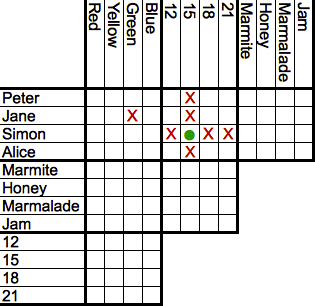Just to review, here's a description from Wikipedia:
Another form of logic puzzle, popular among puzzle enthusiasts and available in magazines dedicated to the subject, is a format in which the set-up to a scenario is given, as well as the object (for example, determine who brought what dog to a dog show, and what breed each dog was), certain clues are given ("neither Misty nor Rex is the German Shepherd"), and then the reader fills out a matrix with the clues and attempts to deduce the solution. These are often referred to as "logic grid" puzzles. The most famous example may be the so-called Zebra Puzzle, which asks the question Who Owned the Zebra?.
Here are some potential rules:
1. Each clue is printed on a separate card;
2. An equal number of cards are dealt to each team. Remaining cards are turned face up for everyone to see;
3. Teams take turns filling in cells with x's and o's. There is no limit to the number of cells that can be filled in a single turn.Teams receive one point for every correct x and ten points for every correct o. Incorrect guesses cause a team to lose a turn. If the incorrect guess was an o and the cell was actually an x, the moderator fills in that one cell. If the incorrect guess was an x and the cell was actually an o, the moderator will fill in the o-cell and will put x's in the cells of the row and column containing the o.
4. After each turn, the team that just went will have a chance to trade cards with other teams. Teams must describe their cards honestly though they can withhold information. For example "Our card involves Alice and honey" could describe the clue "Alice ate the honey" or "Alice did not eat the honey" or "Either Alice ate the honey or Simon ate the jam."
5. Teams can copy clues before trading them away.
Still very much in the early stages. Let me know if you can come up with something better.








%2B059CLEANbrightdim660x900comp92.jpg)